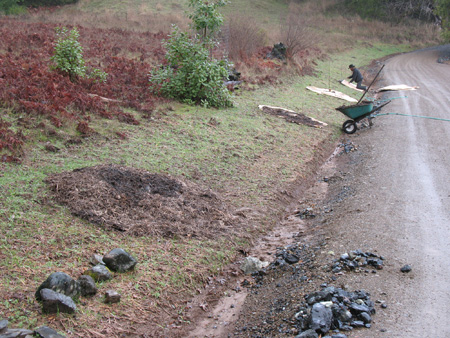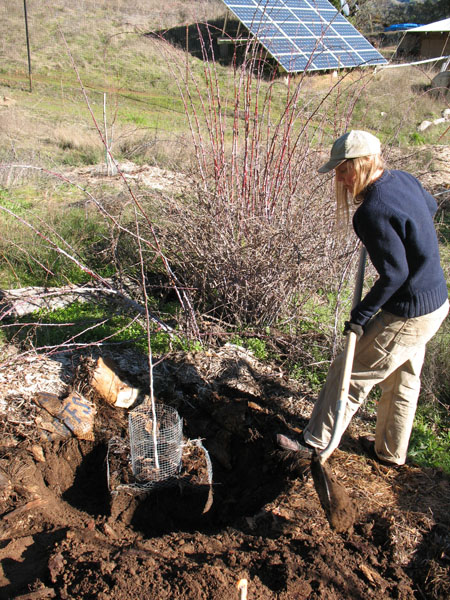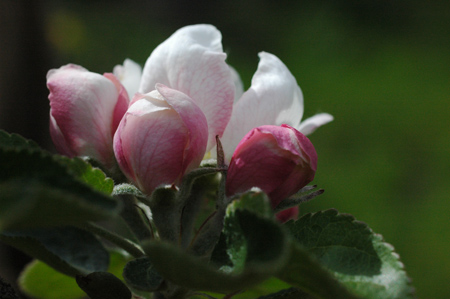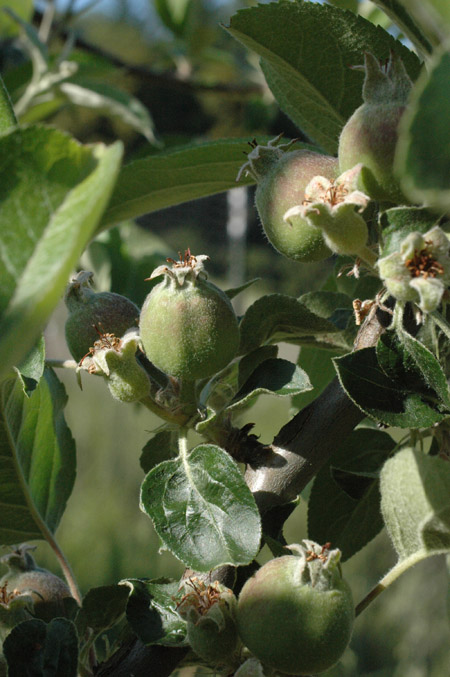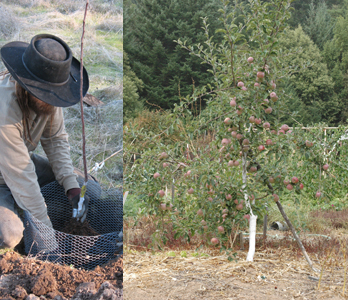"Annual vegetables are like getting a goldfish. Trees are like getting a tortoise that might outlive us."
When we moved here to Turkeysong six and a half years ago, it was a very rainy December. We moved into a tiny trailer with just a propane oven for heat. I was rather unhealthy that winter with long continuing complications from Lyme disease, so my physical resources were limited. But it was an exciting time and full of promise as we embarked on a long held dream. Bathing was accomplished at the nearby hot springs most of the winter until I built a wood fired bathtub which worked passably well. Parking was a mile walk down the 4 wheel drive only road, and the winter was so wet that only two trips were made driving in the 1/2 mile driveway before late spring arrived. I carried office chairs, a desk and sheets of plywood down the half mile drive. I remember many times walking in at night after bathing at the springs, exhausted, sick, dizzy and weak. Most days I spent laying down alone in the damp cold miserable trailer feeling ill and tapped out. The Accommodations were very uncomfortable, but frugality ruled the day and I still knew where my priorities lay. Rather than move toward better shelter, showers, making the driveway passable or other creature comforts, I started preparing to plant trees and put in a garden.
I don’t get why everyone doesn’t see fruit and nut trees the way that I do, or make them a priority. Once established they can give so much for the effort expended in establishment and maintenance. Trees also have a charisma and substance that is of a nature very different than other plants. You can’t develop much of a relationship with a broccoli plant in one season. Annual vegetables are like getting a goldfish. Trees are like getting a tortoise that might outlive us.
Trees currently on the place are 11 Olive, 40 Apple, 9 Sweet Cherry, 2 Pie Cherry, 3 Chestnut, 8? Almond, 9 Carpathian Walnut, 3 Asian Plum, 7 Prune, 5 Feijoa, 2 Loquat, 5 European Pear, 1 Asian Pear, 2 Persimmon, 1 Jujube, 4 fig, 2 chilean wine palm, 1 jelly palm, 1 mulberry and some other odds and ends not counting 55 apples trained as diagonal cordons and a nursery full of trees for next year. After 6 years of planning, researching, planting, mulching, weeding, training, pruning, and occasionally watering and feeding, we are beginning to see results!
I’ve been delighted to see my efforts growing into something resembling trees. Since I do almost all of my own grafting, I’m a year, or even two, behind those buying trees in a nursery. When the young trees come out of the nursery bed the year after grafting, most of them are a single whip, or maiden which is a sapling with no branches around 2 to 5 feet tall, so it is some time before they really take shape and come to a size that suggests they be taken seriously. The spring orchard, which contains most of the trees first planted here, is beginning to take the visual form of an orchard now with some of the trees being 8x8 or larger which is big enough to support a significant crop.
And this year, on the wings of a warm spring, came fruit. Weeks of nice weather had bees out and busy pollinating. The trees were studded with fruitlets thick enough to break branches if they were all left to grow. I’ve delighted in watching my trees develop, cherishing each phase in their development. The graft “taking” and starting to grow is the first victory. A healthy Maiden in the fall is the second. Tucked in place the next spring they wait to begin the first season in the ground. Over the next few years of battling weeds, voles and bark beetle grubs they grow larger, more self sufficient and I can usually take satisfaction in the realization of a strong framework of well placed branches. They begin to bloom, and maybe even set a fruit or two. One day I look at them and they look something like a tree complete with fruit, being off on the right root and leaving their childhood years behind.
Fruit is good. I want to eat fruit and juice it and dry it and make alcohol from it, cook it, can it, ferment it and sell it, but this is not just any fruit! A great share of the energy put into trees here is put into research and planning. The first year my only real resource besides a few other fruit enthusiasts was a book called Cornucopia. It is a really cool book with descriptions of food plants, including varieties. There are a lot of Apples listed in Cornucopia, but even if interested I could not find many of them on short notice and the listing is on the order of hundreds while there are actually thousands of varieties. This person has catalogued 11,324 varieties of Apples! No doubt that number includes some repeats under different names, but no doubt that there are also many varieties missing. I began researching apples in more earnest in the past 3 years. During that time the amount of information about Apple varieties available in cyberspace has grown tremendously. The most useful information is often quite old, especially the mid to late 1800’s, such as Dr Hogg’s The Fruit Manual and up into the early part of the last century like Bunyard’s A Manual of Hardy Fruits More Commonly Grown In Great Brittain, and many more. I’ve spent untold hours researching apple varieties. Much of my down time when I’m too tired to work on other stuff has been spent searching for information and sources on hundreds of Apple varieties. I have fairly extensive data base entries of apple research to draw on and use them regularly. On top of that go notes about growth, tree health, ripening times and tasting of apples grown here. Not every fruit grower needs to be as enthusiastic as the likes of me to grow good fruit, but I can tell you that due care in the selection of varieties pays off.
I research whatever I’m planting generally. I don’t want to leave my decisions up to a nursery owner who may not be familiar with the many varieties of fruits out there. Also, most nurseries are only able to order a limited number of varieties, even though that is improving with renewed interest in heirlooms. Mostly I research Apple varieties because I plant more apples than any other fruit or nut. I’m fascinated by the apple. I long ago recognized the utility and greatness of the apple as the king of homestead fruits. It can be dried, sauced, baked, made into juice, cider, apple butter, dried apples, vinegar, brandy, pies and tarts, eaten off the tree or eaten or cooked after storing for months. There are apples that ripen in July and Apples that ripen in February and probably later... at least 6 months of apples fresh off the tree and I’m confident that this period can be extended.
I’m continually frustrated trying to talk about Apples with people. Its the same conversation over and over. “I like (insert grannysmith, golden delicious, pink lady, honeycrisp, fuji or other grocery store apple)”. “I like a crunchy apple”. “I don’t like mushy apples”. The conversation on apples is generally a limited debate. Its kind of like politics... “I like the Democrats”... “I like the republicans”... “I like one of the two new guys”... Like I said, a limited debate. I want to grab people and shake them and try to get them to listen to me when I tell them what they are missing, but by the time I start trying to tell them they are already telling me that they don’t like mushy apples. Well, almost nobody likes mushy apples, but the range of debate should not be limited to mushy v.s. crunchy and sweet v.s. tart; the world of apples is so much broader.
I like some of the apples I am already familiar with very much, but what I’m doing now is exploring my options- playing the field so to speak. I want to expand the season for apples as far as possible in both directions with first rate apples. That means planting and fruiting a lot of varieties to see what does well here and what suits our tastes. That means a lot of sampling! Some of my best memories of last fall and early winter were climbing into bed of an evening with tonia and an apple or two or three or four and doing some tasting. Sometimes a new one, but always approached as a new one because every one, even off the same tree at the same time, can taste a little or even a lot different. Over the years here I’ve collected around 220 varieties. Frankentree alone has about 140 varieties on him. In total, we have probably 60 or 70 varieties fruiting this year, a new level of apple tasting and eating. Hell yeah, now that's my idea of a good time!
I hope to be finding time to write more about apples since I put a lot of energy into them and I just like to talk about them; and no doubt I’ll be posting about some of the apples we’re tasting this year as the fruits of labor drop ripe and plump into our hands. But I suppose that what I really wanted to communicate here is my excitement at finally seeing my plans come to fruition and how worth it all the inconvenience and labor has been whatever the cost. We are still cooking and scraping by in the same crappy kitchen trailer and sleeping in half finished structures with no real doors or windows, but even if thats the case for another winter, at least we have trees that will be beginning to bear heavily of awesome and carefully selected fruits. The best time to plant a tree really is 10 years ago, but it turns out that 6 years ago isn’t so bad either.
Some parting advice:
*Take any advice with a grain of salt.
*Plant trees sooner rather than later.
*Don’t plant more than you can take good care of.
*Check with the local nursery, but check more with local fruit enthusiasts. Follow up leads with internet research. Many of the best fruits are little known and grown.
*Don’t make caramel popcorn while standing naked in front of a hot wood stove.
*Rarely plant more than one tree of any variety for home use and consider making some trees multiple varieties to span a greater range of seasons and/or tastes.
*Don't discount either Heirlooms or Modern apples. Many of both are excellent and Unique. Heirlooms are romantic, but not always superior. Many of both just plain suck.
*Learn to graft so that you can change trees to new varieties or add to your collection if you find something promising.
*Use the internet to research varieties you are interested in using the terms >> “apple name” apple variety <<. Orange Pippin and Adam’s Apples are a couple of good current sources. Google books rocks the older sources.
*Stay tuned for more hot Pomeography! Including sublimely tempting photos, tantalizing descriptions and verbose romantic ramblings on the virtues and charms of apples!



